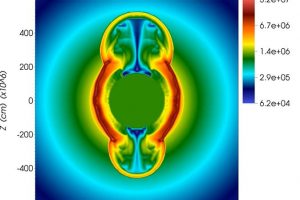An aspherical explosion to explain SN 1987 A properties. The study “Matter Mixing in Aspherical Core-collapse Supernovae: Three-dimensional Simulations with Single Star and Binary Merger Progenitor Models for SN 1987A” of M. Ono (Astrophysical Big Bang Laboratory) recently appeared on ApJ

A supernova exploded on 1987 February 23rd in the Large Magellanic Cloud, a satellite galaxy of the Milky Way. Being at a distance of “only” 170000 light years from us, this supernova, named SN 1987 A, is the closest supernova exploded in the modern era, and thus it is a template to understand the physics of supernova explosions and the formation and evolution of the supernova remnants (the expanding clouds produced by supernovae explosions).
Several authors have tried to connect the physical properties of the supernova remnant obtained from reiterated observations across the last 30 years, with the geometry of the explosion and the properties of the progenitor. These models typically assume a spherical geometry for the explosion, which however do not reply perfectly the properties of remnant. For instance, the presence of layers and clumps overabundant of specific chemical species and isotopes (such as 56Ni) expanding with velocity of several thousand km/sec, requires a non spherical explosion with the development of a jet-like feature and an efficient chemical mixing inside the progenitor (in the simplistic model of evolved giant stars, they are made of layers with an overabundance of specific elements produced by thermonuclear reactions during their late evolution).
The team of researchers led by the astronomer M. Ono (The Astrophysical Big Bang Laboratory, RIKEN, Saitama, Japan), counting also the astronomers S. Orlando (INAF – Astronomical Observatory of Palermo) and M. Miceli (University of Palermo), developed new tridimensional hydrodynamic models of SN 1987 A, accounting for a non spherical geometry of the explosion and different types of progenitor (the star Sanduleak -69° 202). In the model that better reproduces the observations, the progenitor is a Blue Supergiant star resulting from the merging of two massive stars after a phase of common envelope. In these binary systems, the two stars are surrounded by a common envelope of gas, whose drag force pushes the two stars closer with the time, until they compenetrate in the most extreme cases. This model also accounts for the formation of an inhomogeneous nebula around SN 1987A, which formed about 20000 years ago due to the interaction of the slow and dense wind of the red supergiant phase with the faster and less dense wind of the blue supergiant phase. The interaction between the expanding shock after the explosion and this nebula shaped the supernova remnant during its evolution. The study is described in the paper “Matter Mixing in Aspherical Core-collapse Supernovae: Three-dimensional Simulations with Single Star and Binary Merger Progenitor Models for SN 1987A“, recently appeared on The Astrophysical Journal.
The figure (click here to see the entire figure) shows a density map of the best model of the explosion of SN 1987 A after 0.3 sec.
Mario Giuseppe Guarcello ( follow mguarce)
